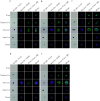Identification and characterization of DNA endonucleases in Plasmodium falciparum 3D7 clone
- PMID: 29914511
- PMCID: PMC6006590
- DOI: 10.1186/s12936-018-2388-0
Identification and characterization of DNA endonucleases in Plasmodium falciparum 3D7 clone
Abstract
Background: Plasmodium falciparum is the most virulent parasite of the five Plasmodium species that cause human malaria, and biological analysis of the parasite is critical for the development of novel strategies for disease control. DNA endonucleases are important for maintaining the biological activity, gene stability of the parasite and interaction with host immune systems. In this study, ten sequences of DNA endonucleases were found in the genome of P. falciparum 3D7 clone, seven of them were predicted to contain an endonuclease/exonuclease/phosphatase (IPR005135) domain which plays an important role in DNA catalytic activity. The seven DNA endonucleases of P. falciparum were systematically investigated.
Methods: Plasmodium falciparum 3D7 clone was cultured in human O+ RBCs, RNA was extracted at 8, 16, 24, 32, 40, and 48 h post invasion and real-time quantitative PCR was carried out to analyse the transcription of the seven DNA endonuclease genes in asexual stages. Immunofluorescence assay was carried out to confirm the location of the encoded proteins expressed in the erythrocytic stages. Finally, the catalytic activity of the DNA nucleases were tested.
Results: Of the seven proteins analysed, two proteins were not soluble. Fragments derived from the rest five endonuclease sequences were successfully expressed as soluble proteins, and which were used to generate antisera for protein localization. The proteins were all located in the nucleus at ring and trophozoite stages. While at schizont stage, proteins encoded by PF3D7_1238600, PF3D7_0107200 and PF3D7_0319200 were in the punctuated forms in the parasite most likely around nuclei of the merozoites. But the proteins encoded by PF3D7_0305600 and PF3D7_1363500 were distributed around the infected erythrocyte membrane. The enzymatic activity of the recombinant GST-PF3D7_1238600 was very efficient without divalent iron, while the activity of the rest four enzymes was iron dependent. Further, divalent irons did not show any specific enhancement on the activity of GST-PF3D7_1238600, but the activity of GST-PF3D7_0107200, GST-PF3D7_1363500 and GST-PF3D7_0319200 were Cu2+ dependent. The activity of GST-PF3D7_0305600 was dependent on Mg2+ and Mn2+. Except GST-PF3D7_1363500, four of the GST tagged recombinant proteins hydrolysed the supercoiled circular plasmid DNA with or without divalent metal ions. The GST-PF3D7_1363500 protein only changed the supercoiled circular plasmid DNA into nicked plasmids, even with Cu2+.
Conclusions: Fragments derived from five of the endonuclease sequences of P. falciparum 3D7 clone were successfully expressed. The proteins displayed diverse cell distribution, biochemical and enzymatic activities, which indicated that they carried different biological function in the development of the parasite in the erythrocytes. The DNA repair and DNA degradation capacity of the DNA endonucleases in the biology of the parasite remained further studied.
Keywords: Catalysis; DNA endonuclease; Malaria; Plasmodium falciparum.
Figures







References
-
- Kantele A, Jokiranta S. Plasmodium knowlesi—the fifth species causing human malaria. Duodecim. 2010;126:427–434. - PubMed
-
- Takeshita H, Mogi K, Yasuda T, Nakajima T, Nakashima Y, Mori S, et al. Mammalian deoxyribonucleases I are classified into three types: pancreas, parotid, and pancreas-parotid (mixed), based on differences in their tissue concentrations. Biochem Biophys Res Commun. 2000;269:481–484. doi: 10.1006/bbrc.2000.2300. - DOI - PubMed
MeSH terms
Substances
Grants and funding
LinkOut - more resources
Full Text Sources
Other Literature Sources
Research Materials

